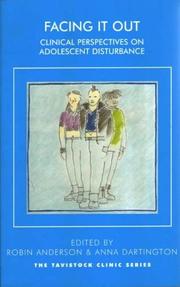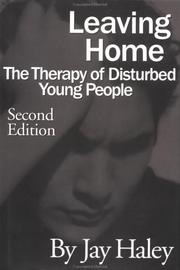Book
Year: 1985 Publisher: Halle (Saale) : Abt. Wissenschaftspublizistik der Martin-Luther-Universität,
Abstract | Keywords | Export | Availability | Bookmark
 Loading...
Loading...Choose an application
- Reference Manager
- EndNote
- RefWorks (Direct export to RefWorks)
Book
ISBN: 1283906287 0857003917 9780857003911 9781849050340 1849050341 Year: 2010 Publisher: London ; Philadelphia : Jessica Kingsley Publishers,
Abstract | Keywords | Export | Availability | Bookmark
 Loading...
Loading...Choose an application
- Reference Manager
- EndNote
- RefWorks (Direct export to RefWorks)
Trauma can result from a range of experiences from bullying to witnessing violence to living through war. This book explores the different reactions children may experience, and the impact trauma can have. Appropriate and effective ways of helping children after a traumatic event are outlined, and different types of therapy are discussed.
Book
ISBN: 0429911009 0429896778 0429472005 1282900811 9786612900815 1849407878 9781849407878 9781855757080 1855757087 Year: 2010 Publisher: London Karnac Books
Abstract | Keywords | Export | Availability | Bookmark
 Loading...
Loading...Choose an application
- Reference Manager
- EndNote
- RefWorks (Direct export to RefWorks)
This book draws together work from across Europe by leading clinical researchers who have been looking into the effectiveness of psychoanalytic interventions. They are mostly time limited, brief, non-intensive ways of working so are applicable in many settings and can therefore be generalised to other clinical teams. The populations worked with are diverse and often present mainstream services with refractory clinical problems, so an applied psychoanalytic approach is well worth trying given the evidence presented in this volume. There is in addition an excellent theoretical chapter on the issues for such clinical research from Stephen Shirk which merits consideration by those wanting to evaluate their own work. This book has had a long gestation but it is an important contribution to services for child and adolescent mental health services to ensure the full menu of interventions is retained in these times of financial restraint with increasing family distress and concerns about inadequate parenting, family breakdown and troublesome adolescents.

ISBN: 1780497873 0429913516 9780429896917 0429899289 0429474512 1283125285 9786613125286 1849402434 9781849402439 1855759675 9781855759671 1855759675 Year: 2002 Publisher: London New York Karnac
Abstract | Keywords | Export | Availability | Bookmark
 Loading...
Loading...Choose an application
- Reference Manager
- EndNote
- RefWorks (Direct export to RefWorks)
"Based on the wealth of experience gathered in the forty years of the life of the Adolescent Department at the Clinic, this covers a full range of clinical work with some of the most difficult areas of adolescence, but it also gives a conceptual framework of normal adolescence and traces the difficulties that arise when this goes wrong. Facing It Out presents new work which has not previously been fully described. The book will be vital reading for clinicians whose work includes work with adolescents. The Adolescent Department of the Tavistock Clinic in its long history has been engaging with young people and their families when the strains prove too great. In this book, staff of the Adolescent Dept examine in accessible language different clinical aspects of adolescent disturbance, exploring in particular the impact on the family. The chapters look at a range of severity of disturbance from adjustment crises to anorexia nervosa and psychosis as well as aspects of adolescent development in small families and in the formation of a sense of identity. With the exception of infancy, adolescence is the most radical of all developmental periods. In the few years between puberty and adulthood, one's sense of oneself must adapt to physical changes of size, shape, strength, and to full sexual and reproductive capacity. Socially there is the need to develop the capacity for intimate relationships and to survive the initiation into the workplace via the demanding examinations: all this in a complex and dangerous world."--Provided by publisher.

ISBN: 0876308450 Year: 1997 Publisher: Brunner/Mazel
Abstract | Keywords | Export | Availability | Bookmark
 Loading...
Loading...Choose an application
- Reference Manager
- EndNote
- RefWorks (Direct export to RefWorks)
Book
ISBN: 2880491150 Year: 1997 Publisher: Chêne-Bourg Editions Médecine et Hygiène
Abstract | Keywords | Export | Availability | Bookmark
 Loading...
Loading...Choose an application
- Reference Manager
- EndNote
- RefWorks (Direct export to RefWorks)
Book
ISBN: 9789044137224 Year: 2019 Publisher: Antwerp Apeldoorn Garant
Abstract | Keywords | Export | Availability | Bookmark
 Loading...
Loading...Choose an application
- Reference Manager
- EndNote
- RefWorks (Direct export to RefWorks)
Book
ISBN: 0429054025 Year: 2020 Publisher: Milton Park, Abingdon, Oxon ; New York, nY : Routledge,
Abstract | Keywords | Export | Availability | Bookmark
 Loading...
Loading...Choose an application
- Reference Manager
- EndNote
- RefWorks (Direct export to RefWorks)
"Therapy referrals for a child or young person can be motivated for a number of reasons. The parents, carers or professionals responsible for their wellbeing might describe a sudden change in presentation, risk taking behaviour, such as self-harm or experimentation with drugs, alcohol or sex, or they might label the young person as over reacting, under reacting or attention seeking. Such behaviour prompts concern for their safety and confusion about why the child or young person is presenting the way they are. This book offers a thoughtful approach to making sense of such behaviour and encourages adults to 'reflect on' rather than 'react to' young peoples' outward presentations. Based on the author's work with children, young people and families over two decades, this book shares reflections from the therapy room and illustrates how the therapist can try to make sense of mood, behaviour and presentations that previously made no sense. The content relies heavily on clinical experience as well as drawing on classical and contemporary psychotherapeutic literature. So often adults find themselves reacting to observable behaviour in a judgmental or punitive way, rather than pausing to consider what the behaviour might be communicating. The author aims to model a thoughtful reflective approach to making sense of what might be going on for children and young people and this book will be of great interest to child and adolescent psychotherapists, related professionals and those with an interest in young persons' mental health"--
Book
ISBN: 0429437544 0429794355 Year: 2018 Publisher: Boca Raton, FL : Routledge,
Abstract | Keywords | Export | Availability | Bookmark
 Loading...
Loading...Choose an application
- Reference Manager
- EndNote
- RefWorks (Direct export to RefWorks)
Nurturing Children describes children’s lives transformed through therapy. Drawing on decades of experience, internationally respected clinician and trainer Graham Music tackles major issues affecting troubled children, including trauma, neglect, depression and violence. Using psychoanalysis alongside modern developmental thinking from neurobiology, attachment and trauma theory and mindfulness, Music creates his own distinctive blend of approaches to help even the most traumatised of children. A mix of personal accounts and therapeutic riches, Nurturing Children will appeal to anyone helping children, young people and families to lead fuller lives.
Book
ISBN: 9781683737063 1683737067 Year: 2023 Publisher: Eau Claire, WI : PESI,
Abstract | Keywords | Export | Availability | Bookmark
 Loading...
Loading...Choose an application
- Reference Manager
- EndNote
- RefWorks (Direct export to RefWorks)
In the DBT, CBT, and Play Therapy Toolbox, you'll find over 200 ready-to-use worksheets and activities designed to help kids and adolescents build social-emotional skills, develop greater insight, and process their struggles in a playful yet therapeutic manner.

 Search
Search Feedback
Feedback About UniCat
About UniCat  Help
Help News
News